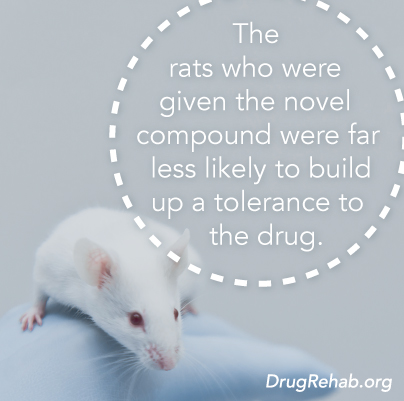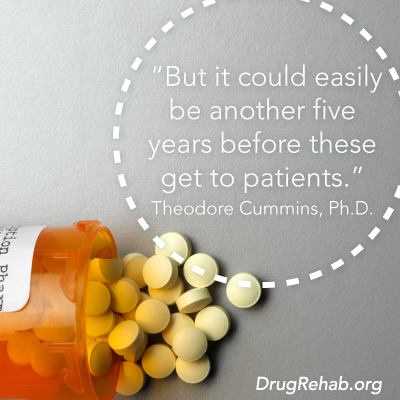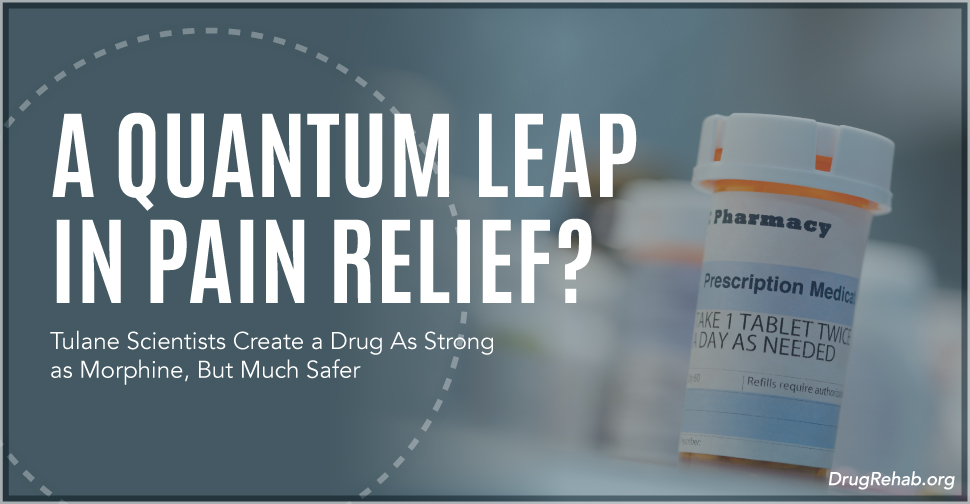A new painkiller that rivals the power of morphine – but with far less risk for addiction or other harmful side effects – is in development at Tulane University. The discovery could help blunt America’s epidemic of opioid deaths and one day provide relief for millions of people living with chronic pain.
Early findings published in the journal Neuropharmacology reveal the compound to be a safer, superior alternative to morphine when tested in rats.
“We have shown that it produces pain relief of equal or greater duration relative to morphine, but with substantially reduced side effects,” says lead researcher James Zadina, Ph.D., a Professor of Medicine, Neuroscience and Pharmacology at Tulane University School of Medicine and the Director of the Neuroscience Laboratory at the Southeast Louisiana Veterans Health Care System.
 Compared with rats who were given morphine, the rats who were given the novel compound were far less likely to build up a tolerance to the drug. And that outcome lowered the risk of abuse and overdose, since tolerance often requires higher and higher doses to feel the same euphoric high or pain-numbing effect.
Compared with rats who were given morphine, the rats who were given the novel compound were far less likely to build up a tolerance to the drug. And that outcome lowered the risk of abuse and overdose, since tolerance often requires higher and higher doses to feel the same euphoric high or pain-numbing effect.
Zadina says that in additional tests, his research team “found that morphine – but not our compound – produced effects associated with reward and drug-seeking.”
The new compound also relieved pain without other harsh side effects such as respiratory depression, a substantial slowing of breathing that can cause fatal overdose. In contrast, rats given a similar potent dose of morphine had “significant respiratory depression,” according to the study. Motor impairment – which can reduce quality of life among older adults taking opioids – was significant in the morphine-fed rats, but not in those on the experimental drug.
For years, scientists at Tulane and elsewhere have been trying to isolate the pain-relieving powers of opioids from their risky side effects.
“We believe that the profile of our compound, given the importance and extent of the reduced side effects, is unprecedented,” Zadina says.
20 Years in the Making
What Tulane researchers have created is a synthetic version of endomorphin – a pain-relieving neurochemical that occurs naturally in the body.
Zadina led the discovery of endomorphins in the brain in 1997. Since then, he and his team have attempted to engineer variations of endomorphin that are more stable and effective as a drug than the compound in the brain. The goal of these synthetic versions is to maximize pain-relieving properties while minimizing negative side effects.
“We have been working about 20 years, since the discovery of endomorphin, to achieve these goals,” Zadina says. “Our motivation is to address two separate but related major issues in our society: the need for effective pain relief for the large number of people in pain with inadequate treatment, and to reduce the devastating epidemic of opioid overdose deaths.”
Endomorphins bind to the same receptor – technically known as the “mu” opioid receptor, or MOR – as morphine, heroin and other opioid drugs.
But there’s a key difference between morphine and Zadina’s synthetic painkiller. Unlike morphine, the novel compound did not activate glial cells in the spinal cord, which play an important role in generating pain.

Research shows that when glial cells are activated by opioids such as morphine, they produce an inflammatory effect that triggers more pain sensations. This contributes to drug tolerance and addiction.
Glia cells were dubbed the “bad guys” in pain control at a research conference sponsored by the National Institute on Drug Abuse:
“Glia (microglia and astrocytes) in the central nervous system are now recognized as key players in pain amplification, including pathological pain such as neuropathic pain; compromising the ability of opioids, such as morphine, for suppressing pain; causing chronic morphine to lose effect, contributing to opioid tolerance; driving morphine dependence/withdrawal; and driving morphine reward, linked to drug craving and drug abuse.”
— “Glia as the ‘Bad Guys’ in Dysregulating Pain & Opioid Actions . . .”
Linda R. Watkins, Ph.D., Frontiers in Addiction Research Conference, National Institute on Drug Abuse
Zadina’s compound targets the mu receptors, without activating the glial cells. “Our compound binds to the same receptor (the mu opioid receptor) as most clinically used opioids. But we believe it is acting differently at this receptor to produce a different response in these cells and/or the network of cells that are affected by it,” Zadina says. “For example, glial cells appear to play a critical role in the effects of drugs, and we know that our compound does not have the same effect as morphine on glial cells.
An Urgent Need
As Zadina pursues the next step in his research – FDA approval for human clinical trials – the need for a non-addictive painkiller remains critical.
A staggering number of Americans – estimated at 100 million – suffer with chronic pain, according to the Institute of Medicine (IOM), part of the National Academies of Sciences, Engineering and Medicine. Living in constant physical agony can exacerbate depression and other mental health conditions. And while opioid drugs can mitigate severe pain, they may also cause addiction and other debilitating issues – for example, falls and fractures in older people who are vulnerable to the sedating effects of opioids.
Abuse of opioid painkillers is at an all-time high, and driving a disastrous epidemic of overdose deaths.
In 2015, drug overdose claimed the lives of 52,404 people in the United States – more than car accidents or gun deaths, according to the Centers for Disease Control. Most overdoses involved an opioid such as prescription painkillers (i.e., Oxycontin, Vicodin), illicit fentanyl products or heroin.
Unfortunately, the crisis continues to worsen. A New York Times analysis projects an estimated 62,497 total drug overdose deaths in 2016 (official government figures won’t be available until Dec. 2017, so the estimate could vary). That would be another all-time high, and larger than the total U.S. military casualties in the Vietnam War (58,220).
Amid this epidemic, researchers are working to bring safer painkillers to market.
“Scientists are pursuing many different avenues,” says Theodore Cummins, Ph.D., a pain researcher and professor and chair of the Department of Biology at Indiana University – Purdue University Indianapolis (IUPUI). “Some, like the researchers at Tulane, are working to make opioid-like drugs that are not addictive and do not have the side effects that current opioids do. Others are working on completely different targets, trying to identify drugs that work on different proteins such as sodium channels.”
Sodium channel blockers have been used for decades to treat pain. Dentists often use novocaine, a sodium channel blocker, to numb discomfort, and anesthesiologists use lidocaine for peripheral nerve blocks. However, the current drugs have limitations because they can block pain fibers, heart muscle and brain activity, Cummins explains.
“Numerous university researchers and pharmaceutical companies are trying to develop sodium channel blockers that only target activity in the pain fibers,” he says. “Selective blockers have great promise to target pain without systemic side effects that would compromise heart or brain functions.”
Today’s sodium channel blockers can ease inflammatory pain and other localized pain conditions. But they’re not ideal for general, more widespread pain, Cummins says.
 “It is hoped that newer drugs in the pipeline that specifically block sodium channels in pain nerves can be used to target widespread pain,” he says. “But it could easily be another five years before these get to patients.”
“It is hoped that newer drugs in the pipeline that specifically block sodium channels in pain nerves can be used to target widespread pain,” he says. “But it could easily be another five years before these get to patients.”
Zadina’s compound uses a different mechanism and site of action to relieve pain.
“The sodium channel blockers target peripheral mechanisms – they can be very effective at blocking pain signals . . . from entering the central nervous system,” Zadina says. “We focused on the mu opioid receptor, however, and this target for our compound is present throughout the peripheral and central nervous system where pain is regulated. This is in part why opioids remain the gold standard for alleviating pain.”
Cummins called the new endomorphin drug promising, noting, “it will be crucial to see if the reduced craving and tolerance observed in rats can also be seen in humans.”
That may take some time. Tulane researchers hope to initiate human clinical trials within a few years, but the time frame for getting a drug from lab to market is uncertain.
“Recent statistics indicate that it takes on average eight years to develop a new drug,” Zadina says. “We will move as quickly as possible and our hope is to succeed faster, but predictions about this are difficult.”
For More Information Related to This Article, Be Sure To Check Out These Additional Resources From DrugRehab.org:
- How Prescription Opiates Can Lead To A Heroin Addiction
- Opiate Epidemic Is Changing Pain Management
- Using Naltrexone To Treat Opioid Addiction
- Signs Of Percocet Abuse
- Prescription Drug Abuse Support Groups
Sources
SAFE OPIOID USE: AMERICA STARTS TALKING CAMPAIGN
Includes do’s and don’ts for the safe use of prescription opioids, how to handle an opioid emergency and tools to help you communicate effectively with your doctor or pharmacist:
http://america-starts-talking.com
8 OPIOID SAFETY PRACTICES FOR PATIENTS & CAREGIVERS
http://www.painmed.org/files/eight-opioid-safety-practices-for-patients-and-caregivers.pdf
FIND A PAIN SPECIALIST
Helpful resources from the American Board of Pain Medicine and the American Pain Society:
http://imis.abpm.org/abpmimis/abpm/directory.aspx
http://americanpainsociety.org/education/clinical-centers-guide
ONLINE PAIN MANAGEMENT TOOLS
http://theacpa.org/Pain-Management-Tools
ARTICLE:
“Beyond Opiates: A Whole-Body Approach to Managing Chronic Pain”


